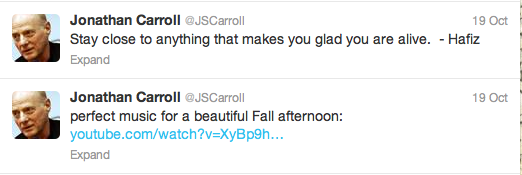It’s an age-old adage that you never thought would apply to social media: you get what you give. Let me explain.
You may not hear this often, but I love my day job. While I’d love for writing to become my full-time gig, for now, I’m loving social media marketing. I work for a good company, have a good boss, and have learned fantastic skills that also carry over into my writing career.
Going into the job, I had a bit of an advantage. Myspace and Facebook were originally marketed to my generation. Contacting friends, making plans, maintaining friendships and asking questions on Facebook walls and feeds is second nature.
However, using social media for marketing purposes seemed quite daunting. Thankfully, it only took a few weeks on the job to realize how wonderful and intuitive marketing on Twitter can be. Let’s work through it.
When I say ‘Twitter marketing’, what’s your first thought? Sponsored ads? Shameless self-promotion? What does marketing on your own Twitter feed look like? I can imagine you’ve seen all of the above (and question your own Twitter strategy from time to time), and it annoys you as much as it does everyone else.
But I guarantee you this: the most effective marketing you’ll ever see on Twitter is a tweet that you don’t even know is marketing.
Here’s an example. Well three of them, actually.
Check out these three authors’ Twitter feeds. You don’t need an account in order to see their tweets:
Jonathan Carroll: https://twitter.com/JSCarroll
Margaret Attwood: https://twitter.com/MargaretAtwood
Amanda Hocking: https://twitter.com/amanda_hocking
The first thing you’ll notice is that all three of these authors are very active on Twitter.  Amanda Hocking has almost as many followers (nearly 25k) as she does actual tweets (over 27k). Not only do these authors post often, but they also re-tweet others and interact with their Twitter followers. These authors are building a relationship with each of their fan bases at large. They are building trust. This should be our first lesson.
Amanda Hocking has almost as many followers (nearly 25k) as she does actual tweets (over 27k). Not only do these authors post often, but they also re-tweet others and interact with their Twitter followers. These authors are building a relationship with each of their fan bases at large. They are building trust. This should be our first lesson.
Next, you may find it curious that they don’t constantly tweet about their books, signings, when their books are on sale, etc. They tweet about their days, they tweet fun pictures, they tweet quotes. Only every now and again do these authors tweet about a book coming out, or a book signing. This is the second lesson: Twitter should not be primarily used for self-promotion.
So how should we use Twitter?
 If we could learn just one lesson from studying these three authors’ Twitter pages, it’s this: you get what you give. This is what most people don’t quite get – at least not right away. The secret to a successful Twitter identity is giving value to those who follow you. Interacting with, encouraging, and accepting your followers as part of your tribe is how you add value to their lives, and how you build a loyal fan base. You appear to be accessible and approachable, which is the key.
If we could learn just one lesson from studying these three authors’ Twitter pages, it’s this: you get what you give. This is what most people don’t quite get – at least not right away. The secret to a successful Twitter identity is giving value to those who follow you. Interacting with, encouraging, and accepting your followers as part of your tribe is how you add value to their lives, and how you build a loyal fan base. You appear to be accessible and approachable, which is the key.
Twitter and other social media sites should only be a part of your overall marketing plan, but it can become your secret weapon. The more you interact – the more you give – the more you will receive in return.
 Kristin Luna is a Marketing Consultant by day and writer by break of dawn. She is currently moving to a house with a swimming pool. Kristin, a descendant of the infamous Dread Pirate Roberts, is working on a Young Adult fantasy trilogy. When she isn’t contemplating marketing campaigns or writing, she’s vacuuming, playing board games, tasting craft beers, watching Homeland, reading, or pushing her clingy cat off of her lap.
Kristin Luna is a Marketing Consultant by day and writer by break of dawn. She is currently moving to a house with a swimming pool. Kristin, a descendant of the infamous Dread Pirate Roberts, is working on a Young Adult fantasy trilogy. When she isn’t contemplating marketing campaigns or writing, she’s vacuuming, playing board games, tasting craft beers, watching Homeland, reading, or pushing her clingy cat off of her lap.



